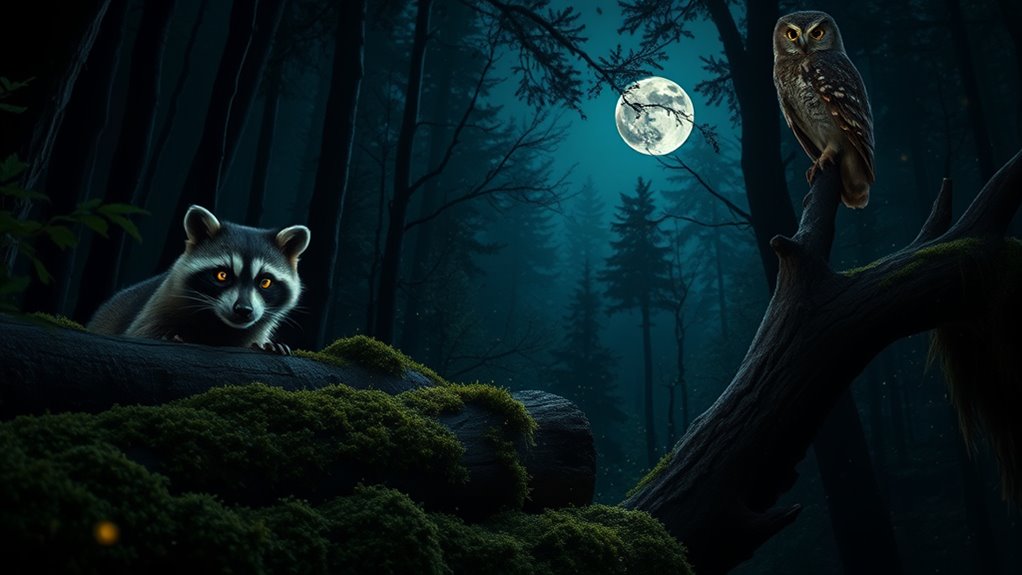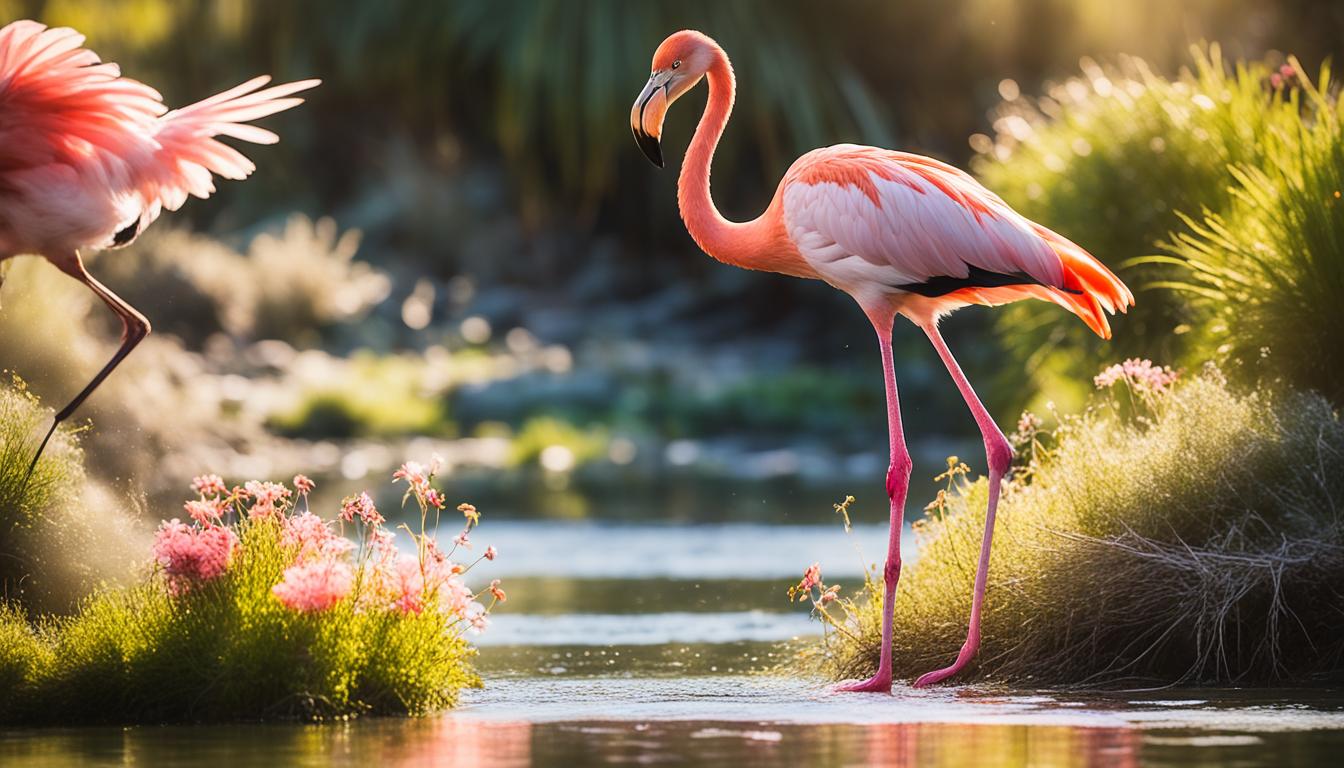Discover the fascinating world of nocturnal animals, creatures perfectly adapted to thrive in darkness. You’ll find owls with large eyes and exceptional night vision, bats that use echolocation to hunt, and foxes with keen senses of hearing and smell. These animals employ unique strategies like camouflage and quick burrowing to survive predators and compete for resources. Keep exploring to uncover more astonishing adaptations that make these night dwellers so remarkable.
Key Takeaways
- Nocturnal animals rely on enhanced senses like sharp hearing, night vision, and smell to hunt and navigate in darkness.
- Creatures such as owls and bats use specialized adaptations like large eyes and echolocation for effective nighttime survival.
- Predator-prey dynamics at night drive unique behaviors, with prey developing camouflage and quick burrowing strategies.
- Nocturnal animals are active during the night to avoid competition and predators, establishing secret communication and territories.
- Studying these creatures reveals evolution’s role in crafting animals suited for complex nighttime ecosystems.

Have you ever wondered what creatures come alive when the sun sets? As darkness falls, a whole new world of animals emerges, each uniquely adapted to thrive in the night. These nocturnal creatures have evolved fascinating adaptations that allow them to navigate a landscape lit only by moonlight and starlight. Their senses sharpen, and their bodies adjust to the cooler, quieter environment, giving them an edge in the complex predator-prey dynamics that dominate the nighttime ecosystem.
Nocturnal adaptations are what enable these animals to hunt, hide, and communicate after dark. Many rely heavily on enhanced senses like acute hearing, exceptional night vision, or a keen sense of smell. For example, owls possess large eyes with a high number of rod cells, allowing them to see in near-total darkness. Bats, on the other hand, use echolocation—sending out sound waves that bounce off objects—to navigate and locate prey with remarkable precision. These adaptations are essential for survival, especially when competing with other predators or avoiding becoming prey themselves. Additionally, the development of specialized body parts, such as elongated limbs or sharp claws, further enhances their ability to hunt or evade threats during nighttime activity.
Nocturnal animals rely on sharp senses like hearing, vision, and smell to hunt, hide, and communicate in the dark.
In predator-prey dynamics, being active at night offers both advantages and risks. Predators like the fox or the big-eyed owl can hunt more effectively in low-light conditions, where their prey may be less alert or less able to see approaching threats. Conversely, prey animals such as rodents or insects have developed their own nocturnal strategies—like quick burrowing, camouflage, or heightened senses—to evade predators. Many prey species are especially alert to sounds or scents that predators emit, enabling them to react swiftly and avoid becoming part of the night’s food chain. These behaviors are often reinforced through evolutionary pressures, shaping the survival strategies of both predators and prey. Interestingly, some nocturnal animals also use their activity during the night to avoid competition from diurnal species, effectively reducing resource competition and predation risk.
You might also notice how some animals use their nocturnal nature to avoid competition. By being active when other species rest, they reduce the chances of running into rivals for food and space. For instance, many insects like moths and beetles take advantage of the night to feed and reproduce, avoiding daytime predators and competitors. This separation in activity times creates a delicate balance, where predator and prey are constantly adapting, each trying to outsmart the other. Moreover, some animals utilize nocturnal behaviors to establish territories and communicate without alerting rivals, further illustrating how evolution shapes these creatures’ lifestyles.
Understanding these nocturnal adaptations and predator-prey dynamics helps you appreciate the complexity of the night’s ecosystem. It’s a domain where evolution has crafted creatures that excel in darkness, turning the night into a vibrant, bustling world filled with activity. Additionally, scientific research into these adaptations aids in developing advanced filtration systems, which can help improve our indoor air quality by capturing tiny particles. So, next time you gaze up at the night sky, remember that beneath the stars, an intricate dance of survival unfolds—a testament to nature’s ingenuity in the shadows.
Frequently Asked Questions
What Are the Benefits of Nocturnal Activity for Animals?
You benefit from understanding nocturnal predator strategies and nighttime animal behaviors because these adaptations help animals avoid predators, conserve energy, and find food more efficiently. By being active at night, animals reduce competition and increase their chances of survival. Recognizing these behaviors reveals how nocturnal creatures thrive in darkness, using specialized senses and tactics to navigate their environment and stay safe while hunting or foraging under the cover of night.
How Do Nocturnal Animals Communicate in the Dark?
You might wonder how nocturnal animals communicate in darkness. They often use bioluminescent signaling, emitting light to send messages or attract mates, especially in deep or dark environments. Ultrasonic communication is also common, where animals produce high-frequency sounds that humans can’t hear, allowing them to coordinate activities or warn others without revealing their location. This combination helps them stay connected despite the absence of daylight.
What Adaptations Help Nocturnal Animals See at Night?
Think of nocturnal animals’ eyes as built-in night vision goggles, giving them sensory enhancements for darkness. Their eye adaptations include larger corneas and pupils, which let in more light, and a reflective layer called the tapetum lucidum that boosts their vision. These adaptations work like a camera’s low-light mode, helping you see clearly in the dark and navigate the night safely and efficiently.
Are Nocturnal Animals More Dangerous Than Diurnal Ones?
You might wonder if nocturnal animals are more dangerous than diurnal ones. While they often face predator threats, their adaptations help them avoid humans and other dangers, making them generally less aggressive. However, some nocturnal predators could pose risks if approached, especially during human interactions. Overall, danger depends on species behavior, not just activity at night, so stay cautious around unfamiliar creatures regardless of their sleep schedule.
How Do Nocturnal Animals Find Food Without Sunlight?
Imagine you’re a fox hunting at night, relying on scent trail navigation rather than sunlight. Nocturnal animals often use bioluminescent hunting, like deep-sea creatures glowing in the dark, or keen senses to find food. They detect prey through scent, sound, or movement, adapting to darkness. This way, they thrive without sunlight, ensuring they can find food efficiently even in complete darkness.
Conclusion
As you explore the world of nocturnal creatures, remember that over 30% of all animal species are active at night, making the night a bustling hub of life. From glowing insects to elusive predators, these animals thrive in darkness, revealing a hidden side of nature most people never see. So next time you’re outside after sunset, think about the fascinating creatures working and playing in the shadows—you’re witnessing a whole world alive when the sun goes down.










